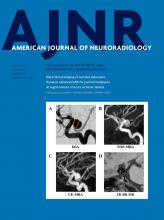Review ArticleAdult Brain
Open Access
Texture Analysis in Cerebral Gliomas: A Review of the Literature
N. Soni, S. Priya and G. Bathla
American Journal of Neuroradiology June 2019, 40 (6) 928-934; DOI: https://doi.org/10.3174/ajnr.A6075
N. Soni
aFrom the Department of Radiology, University of Iowa Hospitals and Clinics, Iowa City, Iowa.
S. Priya
aFrom the Department of Radiology, University of Iowa Hospitals and Clinics, Iowa City, Iowa.
G. Bathla
aFrom the Department of Radiology, University of Iowa Hospitals and Clinics, Iowa City, Iowa.

REFERENCES
- 1.↵
- 2.↵
- Kang Y,
- Choi SH,
- Kim YJ, et al
- 3.↵
- 4.↵
- 5.↵
- 6.↵
- Law M,
- Yang S,
- Wang H, et al
- 7.↵
- Gutman DA,
- Cooper LA,
- Hwang SN, et al
- 8.↵
- 9.↵Texture. Merriam-Webster.com. https://www.merriam-webster.com/dictionary/texture. Accessed January 10, 2019.
- 10.↵
- 11.↵
- 12.↵
- 13.↵
- 14.↵
- 15.↵
- 16.↵
- Constantinides C
- Larroza A,
- Bodí V,
- Moratal D
- 17.↵
- Depeursinge A,
- Al-Kadi OS,
- Mitchell JR
- Szczypiński PM,
- Klepaczko A
- 18.↵
- Schaer R,
- Cid YD,
- Alkim E, et al
- 19.↵
- 20.↵
- 21.↵
- 22.↵
- 23.↵
- 24.↵
- Depeursinge A,
- Fageot J,
- Al-Kadi OS
- 25.↵
- 26.↵
- 27.↵
- 28.↵
- 29.↵
- 30.↵
- 31.↵
- 32.↵
- 33.↵
- 34.↵
- 35.↵
- Upadhaya T,
- Morvan Y,
- Stindel E, et al
- 36.↵
- 37.↵
- 38.↵
- Lee J,
- Jain R,
- Khalil K, et al
- 39.↵
- 40.↵
- 41.↵
- 42.↵
- 43.↵
- Bahrami N,
- Piccioni D,
- Karunamuni R, et al
- 44.↵
- 45.↵
- 46.↵
- 47.↵
- 48.↵
- Zhang X,
- Tian Q,
- Wu YX, et al
- 49.↵
- 50.↵
- 51.↵
- 52.↵
- 53.↵
- 54.↵
- 55.↵
- 56.↵
- 57.↵
- 58.↵
- 59.↵
- 60.↵
- 61.↵
- 62.↵
- 63.↵
- Alcaide-Leon P,
- Dufort P,
- Geraldo AF, et al
- 64.↵
- 65.↵
- 66.↵
- 67.↵
- 68.↵
- Ismail M,
- Hill V,
- Statsevych V, et al
- 69.↵
- 70.↵
- 71.↵
- Schad LR
- 72.↵
- 73.↵
- 74.↵
- 75.↵
- 76.↵
- 77.↵
In this issue
American Journal of Neuroradiology
Vol. 40, Issue 6
1 Jun 2019
Advertisement
N. Soni, S. Priya, G. Bathla
Texture Analysis in Cerebral Gliomas: A Review of the Literature
American Journal of Neuroradiology Jun 2019, 40 (6) 928-934; DOI: 10.3174/ajnr.A6075
0 Responses
Jump to section
Related Articles
Cited By...
- Radiomics-Based Differentiation of Glioblastoma and Metastatic Disease: Impact of Different T1-Contrast-Enhanced Sequences on Radiomics Features and Model Performance
- Impact of SUSAN Denoising and ComBat Harmonization on Machine Learning Model Performance for Malignant Brain Neoplasms
- Image-localized biopsy mapping of brain tumor heterogeneity: A single-center study protocol
- Image-localized Biopsy Mapping of Brain Tumor Heterogeneity: A Single-Center Study Protocol
- Accuracy of magnetic resonance imaging texture analysis in differentiating low-grade from high-grade gliomas: systematic review and meta-analysis
This article has not yet been cited by articles in journals that are participating in Crossref Cited-by Linking.
More in this TOC Section
Similar Articles
Advertisement











